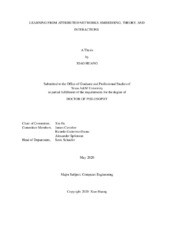| dc.description.abstract | Networks are widely adopted to represent the relations between objects in many disciplines. In real-world scenarios, nodes are often associated with a rich set of data describing their characteristics, such as social networks with user-generated content. We model these systems as attributed networks. They are a unique data structure that simultaneously assesses networks and node individual attributes or content, and pervasive in practice. In this thesis, I present effective, scalable, and human-centric learning algorithms for attributed networks, to enable their actionable patterns to be easily accessible to data consumers.
Most machine learning algorithms make default assumptions that instances are independent of each other, and their features are in Euclidean space. These do not hold for attributed networks. To bridge the gap, attributed network embedding (ANE) aims to learn low-dimensional vectors to represent nodes, such that actionable patterns in original networks and node attributes can be preserved. The learned representations could be directly leveraged by off-the-shelf machine learning algorithms as feature vectors or hidden layers to conduct different tasks. I systematically developed a series of ANE algorithms, which could be categorized into four classes, including coupled spectral embedding, coupled-factorizations-based embedding, joint-random-walks-based embedding, and graph neural networks, to bridge the gap between large-scale networked data and off-the-shelf machine learning algorithms. On this basis, I developed interactive embedding to involve domain experts in advancing the ANE. Experts have a better cognition in the latent information such as domain knowledge and hidden relations. So we could learn from them and incorporate their knowledge into ANE.
My research enables data scientists and domain experts to effectively utilize the abundant but complex information. It broadly impacts fields such as Information Retrieval, Social Computing, Health Informatics, and Bioinformatics. | en |


